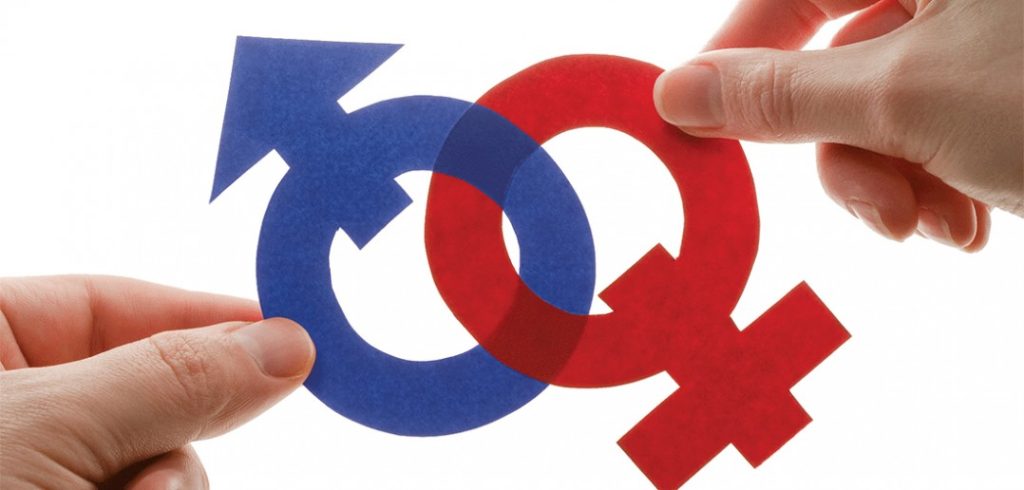
by Fr. Jonathan Cholcher
The subject of gender pervades civil discussion in our society, in recent years expressed with meaning foreign to an understanding common to most people just a decade or two prior. In January 2017, the “National Geographic” magazine identified 29 different “genders,” carefully distinguishing between the terms “gender” and “sex.” Whereas “sex” is traditionally restricted to just two biological possibilities: male, or female (that is, binary; XX or XY chromosomes, specific reproductive organs), “gender” is now used expressing a wide variety of subjective psychological states beyond the biological (non-binary). This whole topic seeks to answer one of the most basic personal questions in life: Who am I?
In Christian Tradition, the subject of gender assumes just two sexes, but also goes beyond the mere biological. Gender is not merely binary, but a trinary reality involving three personal modes of existence. The two sexes male and female, man and woman, are not defined only in relation to one another, but each in relation to the third, that is, God who made them both. Thus each human being finds meaning not in bare diversity of expression in distinction from the other (the quest for absolute individuality), nor in artificial attempts to make the other the same or equal by superficially erasing essential distinctions (cosmetic collectivization). Meaning is ultimately derived in relation to the infinite God who endows humanity with infinite variety just as we are made.
The two genders simultaneously manifest the natural uniqueness of each person and their shared, common nature functioning toward the same goal of participation in God’s transcendent design. This is the meaning of mankind, both male and female, being created in the image and likeness of God (Gen. 1:26-27; Matt. 19:4-6). The ability of a couple, two persons of distinct genders, to give birth to another person perpetuating God’s design is confirmation of the truth and rightness of this trinary reality, particularly as this takes place within the covenant of marriage. The conception and birth of a new child is a new creation of God, not simply a biological process. The context of this creation is the permanent family composed of husband/father, wife/mother, and offspring/children. God’s command to “be fruitful and multiply” (Gen. 1:28) assumes the exercise of certain reproductive facts, but at the same time, can only be fully realized within the system of life given by God.
Gender as a trinary reality images the tri-personal mode of existence of the one Divine Essence Itself. The Son of God begotten of the Father, and the Holy Spirit who proceeds from the Father – two unique and distinctive Persons (Gk., Hypostaseis; Jn. 1:18; 15:26) – are not simply defined only in relation to one another, but each in relation to the third, that is, the Father. The Person of the Father is the un-begotten and un-proceeding Principle and Source of the Son and Holy Spirit. Trinity exists in Unity, and Unity in Trinity, distinct as Persons yet co-equal in Essence, or Nature (Gk., homoousios; Lat., consubstantial).
Every heresy in the history of the Church either divided the Persons by isolating each from the common essence of the others (individuality), or collapsed the uniqueness of each Person into an undifferentiated sameness of essence (collectivism). This heretical tendency applies to Trinitarian doctrine (e.g., Subordinationism, Arianism, Macedonianism, Sabellianism), to the divine-human reality of the Savior Jesus Christ (e.g., Docetism, Nestorianism, Monophysitism, Monothelitism), and to the nature of the Church, that is, human beings created to live in communion with God and one another (e.g., Novationism, Donatism, Messalianism, Iconoclasm, Papalism, Protestantism, Tribalism, Transgenderism).
Gender, therefore, is an existential trinary reality, not merely a subjective, intellectual, or social construct. Gender reveals who we are as unique yet consubstantial creatures intended for a higher, uncreated purpose possible only by participation in the divine life of God Himself. We gladly acknowledge that human beings come in two sexes: male and female, men and women, created as perfect complements (Gen. 2:18, 23) capable of producing together by the grace of God more life beyond themselves.
The condition of “gender dysphoria” is commonly ascribed nowadays to persons whose sense of gender (sexuality) differs from their biological sex (male or female). First of all, over 85% of people who experience gender dysphoria in their youth ultimately resolve to their created sex (gender) once past their teens. In addition, the secular emphasis on gender dysphoria seeks to undermine fundamental facts of life in order to re-shape people’s lives according to a purpose foreign or opposed to that of God the Creator (hence, recent redefinitions of marriage, sex reassignment surgery, etc.). According to our Christian understanding, all such efforts are unnatural (Rom. 1:26-27; 2 Pet. 1:3-4).
Gender dysphoria is a withdrawal and separation from God’s purpose because it is a confusion of our existential trinary reality, not only an elimination of the distinctiveness of male and female, but importantly an elimination of the Divine “in whom we live and move and have our being” (Acts 17:28). We celebrate who we are as unique persons both in relation to each other as made to be and in relation to God as we hope to become together in His grace and everlasting life.
